It’s eight o’clock at night. You’re cutting vegetables when you accidentally take a chunk out of your finger. There’s blood everywhere.
Assuming the finger isn’t severed and you haven’t cut an artery, your first instinct is probably to reach out to your family doctor. At seven or eight at night, you may or may not get a return phone call, but either way, it’s unlikely that he or she will see you right away.
When deciding between Urgent Care or a visit to the Emergency Room, it benefits you and it benefits the Writers Guild Health Plan when you make the best decision for your particular circumstances. It’s no fun sitting in an Emergency Room for hours on end, waiting to get treatment. When your injury/illness isn’t life threatening, the ER is an expensive, time consuming endeavor. Urgent Care does a faster and less expensive job – when it’s the right solution.
You could call 911 for your bloody finger, perhaps go to an Emergency Room, or you could visit an Urgent Care center. 911 is expensive. If you go that route, it means an ambulance trip to an Emergency Room. Even with your Writers Guild Health Plan you may be responsible for up to $2,800 dollars. Typically, the cost for ambulance service to an Emergency Room is $1,200 or more. And when you get to the Emergency Room, the medical staff are going to perform triage to see who gets helped first. You’re not having a heart attack. You’re not in immediate jeopardy of death. You’ll be lucky to get out of there by midnight, with a few stitches and a large bill (click here to see typical scenarios).
The cost of Urgent Care treatment is typically one half to a third of what an Emergency Room costs. The average time from walk-in to exit at Urgent Care centers runs around 45 minutes. If you’re not sure where the nearest Urgent Care center is located, you can find Urgent Care centers in your area by clicking here.
Here’s an example taken from an actual file. The Participant had stomach pains, went to the ER, waited a very long time, and incurred a high bill. The Plan also paid a much higher amount as a result of going to the Emergency Room rather than Urgent Care.
Constipation (Out of Network)
| Bill Type | Billed Amount | Patient Paid* |
| Emergency Room | $8,043.03 | $2,657.91 |
* Parient Paid includes $50 ER copay, $300 deductible and coinsurance
Each year, the Plan spends over a million dollars on Emergency Care, and a significant portion of those visits are better suited to Urgent Care. Making the best decision for your circumstances can help save money – for you and the Health Plan.
